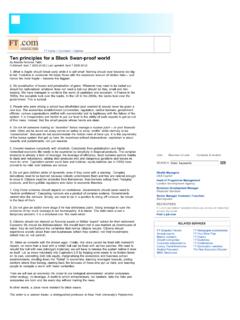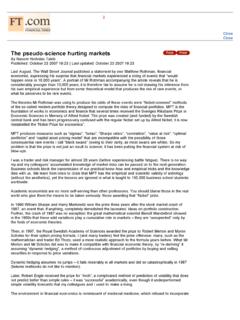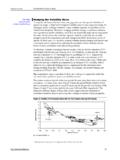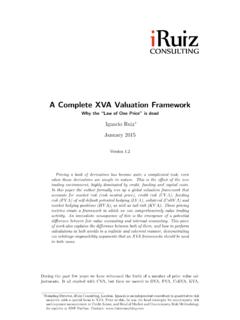Transcription of 1. Dynamic Hedging - Nassim Nicholas Taleb
1 N N Taleb 1. Dynamic Hedging Summary: This chapter introduces the theoretical framework for the analysis of the execution of Dynamic Hedging . A discussion of the issues related to the application of financial theory to the microstructure of Dynamic Hedging is Among these issues is the continuous time problem , the delta paradox . This chapter also presents results related to the simplification of the risk neutral argument. Introduction The bad news is that neoclassical economics cannot easily handle the activity of Dynamic Hedging in an economy in which there are market frictions, asymmetric information, and where the adjustments need to be made in discrete time, in other words the world we truly live in.
2 The good news is that we may not have to. Indeed the very same results can be obtained once one uses some of the accretions to the neoclassical economics of the post Arrow-Debreu era, like industrial organization, the theory of the firm. This chapter will thus focus on the bad news, with the good news to come later chapters. Recall from the general introduction the problem of Dynamic Hedging , which we describe as the attempt to analyze Dynamic Hedging using tools that are N N Taleb not made for it. In other words putting a little bit of microstructure, as has been done, leads to strange results and paradoxes. Completing the analysis miraculously puts it back on its feet. The problem of Dynamic Hedging is that it needs to be done in real time, in a real marketplace, between real economic agents, each with his own set of information, some of which are employed in firms.
3 Most of the analysis of continuous time finance creates problems when applied with microstructure constraints. Ignoring microstructure is possible in some cases of the Arrow-Debreu two-period model, but is no longer possible when one addresses the wrinkles of Dynamic Hedging . The simplifications of the neoclassical paradigm, discussed in chapter 6, while convenient to prove the existence of equilibrium, causes some non-trivial distortions that need to be remedied. This chapter will include most of the foundations on which the rest of the document will be based, by establishing the notion of market structure. Market structure is characterized with the following notions: Discrete time: there is an economic lower bound on time, and not a constant one at that at it varies according to economies1.
4 Time not being continuous there is an uncertainty attending the execution period. Discrete prices: prices are not continuous. There is an economic lower bound on minimum price variations, the minimum tick increment. 1. See Geman and An (1996, 1997). This point is further discussed in the general appendix N N Taleb Information is never complete. We need to set the framework for the discussion of asymmetric information that will be discussed in chapter 3. There exist pronounced asymmetries in the way operators need to execute their hedges; a long option operator's hedges do not correspond to the reverse of those of a short options counterpart. Owing to the absence of continuous prices (and time) the operational hedge ratios can no longer be derived using continuous time methods.
5 Transaction costs exist. But they are complexity (a discussion of this issue will be left to the next chapter and the general appendix). Market structure impacts the risk neutral argument, as the existence of a non-satiated marginal arbitrageur between the cash and forward prices can set some characteristics for the distribution. We note that options are not the only instrument that require Dynamic Hedging . All financial instruments with convex payoff2, which we call nonlinear, need Dynamic replication. Such expansion of the space of the security aims at including within the framework of microstructure analysis non-option instruments that are non-linear in their price, such as bonds with extreme convexity, or nonlinear baskets, tools that need to be dynamically hedged but do not present strictly speaking a strike price.
6 2. By convex payoff is meant a payoff that is convex with respect to a linear state variable. N N Taleb This introductory chapter is organized as follows. We start with a broader definition of a derivative security. We present the microstructure backdrop to the notion of Dynamic Hedging , with a discussion of the informational distinctions between varieties of markets. We discuss the effect of the discreteness of time of portfolio revision policies, a point that will dominate the text and justify it with a presentation of the continuous time problem . We present a simplification of the risk-neutral argument3 by linking it to Keynes' insight and Working's notion of convenience yields. Finally the problem of convergence of the higher moments, the delta paradox is presented.
7 The appendix includes some formal definitions . rephrased . Nonlinear Derivative Security Definition 1-1 A nonlinear derivative security is a security the value of which, V(S,t0), (S,t0) Rn+ x R+, V R+ , depends on the underlying asset price S (also called primary asset ) and time and satisfies either of the following valuation rules: i) The diagonal elements of the Hessian D= 2V/ Si 2 includes, for some S, at least a non 0 component. ii) V(S,t0) depends, for some S, on at least one element of the matrix with elements Cov(Si,Sj). 3. The risk neutral argument is defined in this document as the economic rationale that allows us to use the risk-neutral distribution, or, in more mathematical terms, the equivalent martingale measure, in pricing financial instruments.
8 N N Taleb iii) There exists an and an R for which |V(S,t0) - +. V(S,t0+ )|> .. By value is meant here arbitrage value. The requirement i) (the gamma condition) corresponds to the casual definition that any derivative security presents a positive or negative gamma , a second derivative, with respect to at least one of the underlying instruments. The requirement ii) (the vega condition) means that a derivative security will have a valuation that depends on the volatility of at least one of the underlying assets. The final requirement iii) implies that a derivative security will have time value and that such time value will change over time. iii) makes a distinction between the value of a linear security that is time dependent (like a simple forward contract) and that of a time dependent nonlinear one (a convex bond) in that a time dependent nonlinear one depends on t0, the initial time, whereas the valuation of a linear one does not depends on t04, only t (expiration).
9 Thus: i ii iii a simple application of ItE's lemma5. 4. A forward contract for example, is linear but the price in a risk neutral environment is not expected to change at any t0 owing to the martingale property. 5. It suffices to see that the forward equation requires a derivative with respect to time. N N Taleb Dynamic Hedging Definition 1-2: Dynamic Hedging corresponds to any discrete time self financing strategy pair countable sequence (Qti , Bti)i=0n ,(Rn x R) where Qti is the quantity of units (or shares) of the primitive asset S held at time ti, t0 ti tn and Bti are the cash balances held in a default-free interest bearing money market account that satisfies all of the following: i) Qti is Fti adapted, Fti being the filtration6 Ftj Fti, tj<ti , all information related to Sti.
10 Ii) Etj, j<i(V(St,ti) - Bti+ Qti Sti)i=0 =Order( ) for all ti and tj. n iii) E(U(V(St,t) - Bti+ Qti Sti)))i=0 E(U(V(St,t )- B`ti+ Q`ti Sti))) i=0 , with n n (B`ti,Q`ti)ti=0t any different sequence from (Bti,Qti)ti=0t. iv) n< . Here x is said to be of order( ) if limit x/ bounded when x 0. The notion of order( ) is an artifact introduced here to accommodate the use of a neoclassical marginalist approach without being stopped by some of the fundamental problems as a large share of option theory (like transaction costs analysis) was designed outside of the economics of supply and demand. Intuitively O( ) means 0 in a purely competitive economy. But in some cases where, either absence of risk-neutrality, or other changes in the basic assumptions require the introduction of risk premium may allow us to put a price on.












